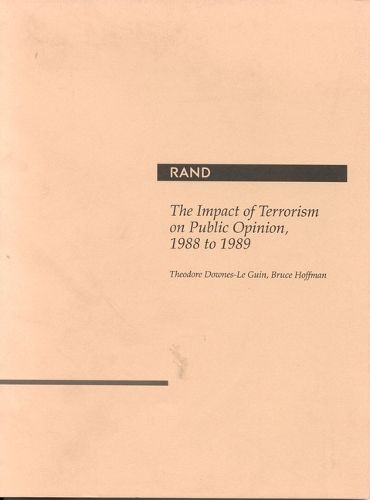Readings Newsletter
Become a Readings Member to make your shopping experience even easier.
Sign in or sign up for free!
You’re not far away from qualifying for FREE standard shipping within Australia
You’ve qualified for FREE standard shipping within Australia
The cart is loading…






This document examines the relationship between terrorism and public opinion and is based on research that was conducted in 1988 and 1989 as part of a study examining the impact of terrorism on the public. The authors look at the relationship on two levels. On a descriptive level, they examined how the public reacts to terrorism and terrorists and elicited its preferences for terrorist countermeasures. On a systematic level, they posited some ideas for how the data may be interpreted in the context of contemporaneous terrorist countermeasure policy. The analysis used data from 1988 and 1989, a period of relatively intense activity for and political sensitivity to international terrorism. The study concludes that the majority of people realize what a complex problem terrorism presents. What people are evidently ready for is more considered–and more flexible–policy and response. In contrast to the rigid no blackmail, no concessions policies that successive U.S. presidential administrations have embraced, at least publicly, there appears to be support for a more flexible policy in dealing with hostage episodes that would allow greater room for maneuver than in the past.
$9.00 standard shipping within Australia
FREE standard shipping within Australia for orders over $100.00
Express & International shipping calculated at checkout
This document examines the relationship between terrorism and public opinion and is based on research that was conducted in 1988 and 1989 as part of a study examining the impact of terrorism on the public. The authors look at the relationship on two levels. On a descriptive level, they examined how the public reacts to terrorism and terrorists and elicited its preferences for terrorist countermeasures. On a systematic level, they posited some ideas for how the data may be interpreted in the context of contemporaneous terrorist countermeasure policy. The analysis used data from 1988 and 1989, a period of relatively intense activity for and political sensitivity to international terrorism. The study concludes that the majority of people realize what a complex problem terrorism presents. What people are evidently ready for is more considered–and more flexible–policy and response. In contrast to the rigid no blackmail, no concessions policies that successive U.S. presidential administrations have embraced, at least publicly, there appears to be support for a more flexible policy in dealing with hostage episodes that would allow greater room for maneuver than in the past.